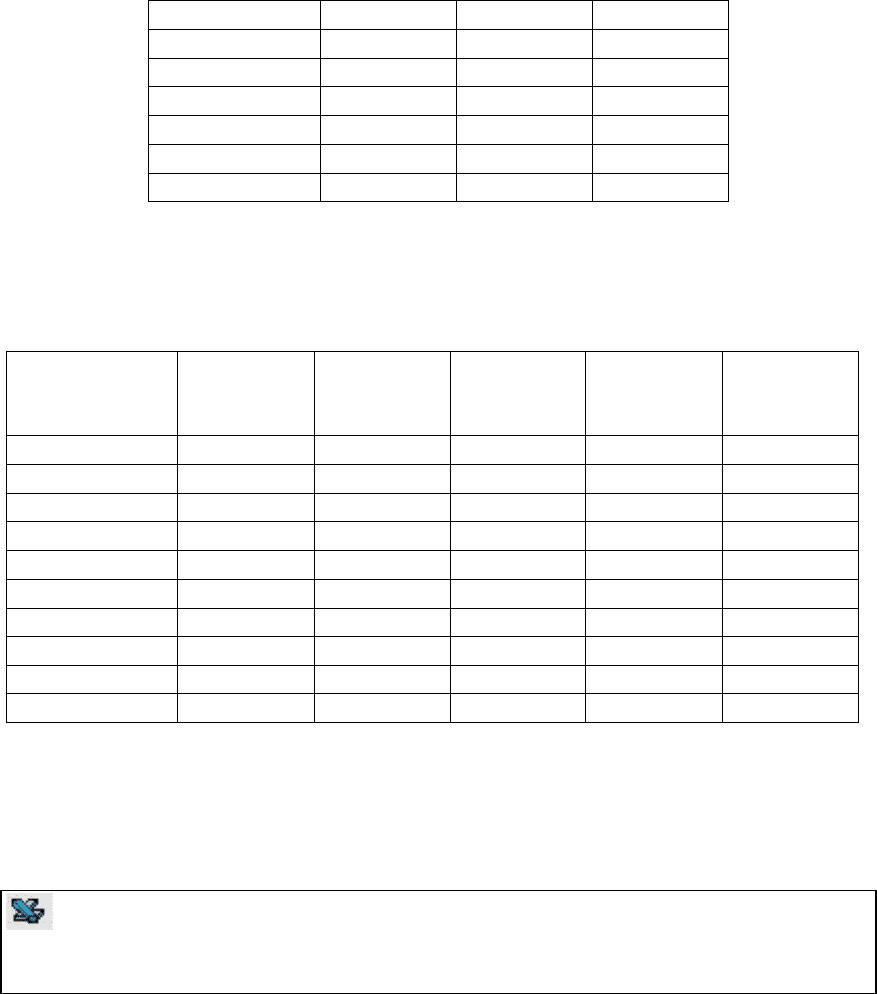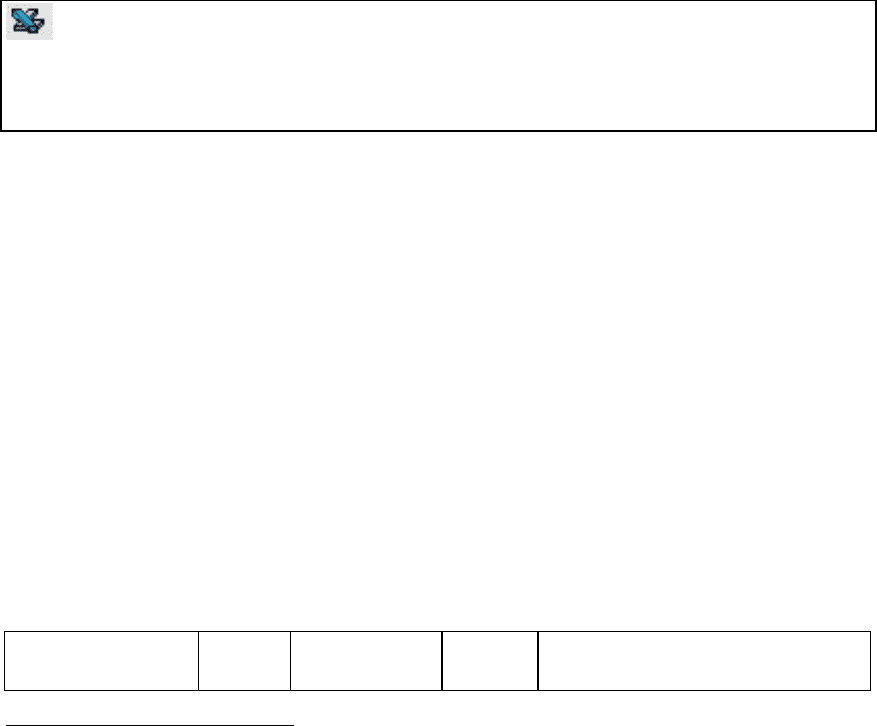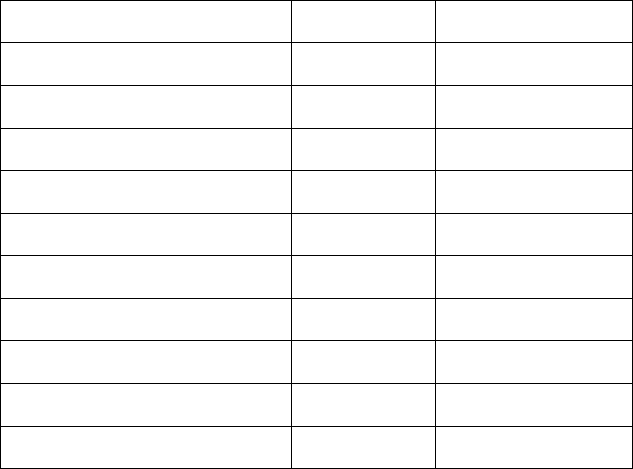Damodaran A. Applied corporate finance
Подождите немного. Документ загружается.


52
52
= $ 69,789 + $ 5,479 - $ 984
= $ 65,294 million
The next step in the process is to estimate the tax savings in table 8.19 at different
levels of debt. While we use the standard approach of assuming that the present value is
calculated over a perpetuity, we reduce the tax rate used in the calculation, if interest
expenses exceed the earnings before interest and taxes. The adjustment to the tax rate was
described more fully earlier in the cost of capital approach.
Table 8.19: Tax Savings From Debt (t
c
D): Disney
Debt Ratio
$ Debt
Tax Rate
Tax Benefits
0%
$0
37.30%
$0
10%
$6,979
37.30%
$2,603
20%
$13,958
37.30%
$5,206
30%
$20,937
37.30%
$7,809
40%
$27,916
31.20%
$8,708
50%
$34,894
18.72%
$6,531
60%
$41,873
15.60%
$6,531
70%
$48,852
13.37%
$6,531
80%
$55,831
11.70%
$6,531
90%
$62,810
10.40%
$6,531
The final step in the process is to estimate the expected bankruptcy cost, based upon the
bond ratings, the probabilities of default, and the assumption that the bankruptcy cost is
25% of firm value. Table 8.20 summarizes these probabilities and the expected
bankruptcy cost, computed based on the levered firm value
Expected Bankruptcy Cost at x% debt
= (Unlevered firm value + Tax benefits from debt at x% debt) * (Bankruptcy cost as % of
firm value) * Probability of bankruptcy
Table 8.20: Expected Bankruptcy Cost, Disney
Debt Ratio
Bond Rating
Probability of
Default
Expected
Bankruptcy
Cost
0%
AAA
0.01%
$2
10%
AAA
0.01%
$2
20%
A-
1.41%
$246
25
This estimate is based upon the Warner study, which estimates bankruptcy costs for large companies to
be 10% of the value, and upon the qualitative analysis of indirect bankruptcy costs in Shapiro and Cornell.

53
53
30%
BB
7.00%
$1,266
40%
CCC
50.00%
$9,158
50%
C
80.00%
$14,218
60%
C
80.00%
$14,218
70%
C
80.00%
$14,218
80%
C
80.00%
$14,218
90%
C
80.00%
$14,218
The value of the levered firm is estimated in Table 8.21 by aggregating the effects of the
tax savings and the expected bankruptcy costs.
Table 8.21: Value of Disney with Leverage
Debt Ratio
$ Debt
Unlevered
Firm Value
Tax Benefits
Expected
Bankruptcy
Cost
Value of
Levered Firm
0%
$0
$65,294
$0
$2
$64,555
10%
$6,979
$65,294
$2,603
$2
$67,158
20%
$13,958
$65,294
$5,206
$246
$69,517
30%
$20,937
$65,294
$7,809
$1,266
$71,099
40%
$27,916
$65,294
$8,708
$9,158
$64,107
50%
$34,894
$65,294
$6,531
$14,218
$56,870
60%
$41,873
$65,294
$6,531
$14,218
$56,870
70%
$48,852
$65,294
$6,531
$14,218
$56,870
80%
$55,831
$65,294
$6,531
$14,218
$56,870
90%
$62,810
$65,294
$6,531
$14,218
$56,870
The firm value is maximized at between 20 and 30% debt, which is consistent with the
results of the other approaches. These results are, however, very sensitive to both the
estimate of bankruptcy cost as a percent of firm value and the probabilities of default.
apv.xls: This spreadsheet allows you to compute the value of a firm, with leverage,
using the adjusted present value approach.
Benefits and Limitations of the Adjusted Present Value Approach
The advantage of the APV approach is that it separates the effects of debt into
different components and allows the analyst to use different discount rates for each
component. In this method, we do not assume that the debt ratio stays unchanged forever,
which is an implicit assumption in the cost of capital approach. Instead, we have the

54
54
flexibility to keep the dollar value of debt fixed and to calculate the benefits and costs of
the fixed dollar debt.
These advantages have to be weighed against the difficulty of estimating
probabilities of default and the cost of bankruptcy. In fact, many analyses that use the
adjusted present value approach ignore the expected bankruptcy costs, leading them to
the conclusion that firm value increases as firms borrow money. Not surprisingly, they
conclude that the optimal debt ratio for a firm is 100% debt.
In general, with the same assumptions, the APV and the Cost of Capital
conclusions give identical answers. However, the APV approach is more practical when
firms are evaluating a dollar amount of debt, while the cost of capital approach is easier
when firms are analyzing debt proportions.
26
This spreadsheet allows you to compute the value of a firm, with leverage, using the
adjusted present value approach.
Comparative Analysis
The most common approach to analyzing the debt ratio of a firm is to compare its
leverage to that of similar firms. A simple way to perform this analysis is to compare a
firm's debt ratio to the average debt ratio for the industry in which the firm operates. A
more complete analysis would consider the differences between a firm and the rest of the
industry, when determining debt ratios. We will consider both ways below.
Comparing to Industry Average
Firms sometimes choose their financing mixes by looking at the average debt
ratio of other firms in the industry in which they operate. For instance, the table below
compares the debt ratios
27
at Disney and Aracruz to other firms in their industries:
Disney
Entertainment
Aracruz
Paper and Pulp (Emerging
Market)
26
See Inselbag and Kaufold (1997).
27
For purposes of this analysis, we looked at debt without operating leases being capitalized because of the
difficulty of doing this for all of the comparable firms.

55
55
Market Debt Ratio
21.02%
19.56%
30.82%
27.71%
Book Debt Ratio
35.10%
28.86%
43.12%
49.00%
Source: Value Line
Based on this comparison, Disney is operating at a debt
ratio slightly higher than those of other firms in the
industry in both market and book value terms, while
Aracruz has a market debt ratio slightly higher than the
average firm but a book debt ratio slightly lower.
The underlying assumptions in this comparison
are that firms within the same industry are comparable,
and that, on average, these firms are operating at or
close to their optimal. Both assumptions can be questioned, however. Firms within the
same industry can have different product mixes, different amounts of operating risk,
different tax rates, and different project returns. In fact, most do. For instance, Disney is
considered part of the entertainment industry, but its mix of businesses is very different
from that of Lion’s Gate, which is primarily a movie company, or Liberty Media.
Furthermore, Disney's size and risk characteristics are very different from that of Pixar,
which is also considered part of the same industry group. There is also anecdotal
evidence that since firms try to mimic the industry average, the average debt ratio across
an industry might not be at or even close to its optimal.
dbtfund.xls: There is a dataset on the web that summarizes market value and
book value debt ratios, by industry, in addition to other relevant characteristics.
Controlling for Differences between Firms
Firms within the same industry can exhibit wide differences on tax rates, capacity
to generate operating income and cash flows, and variance in operating income.
Consequently, it can be dangerous to compare a firm’s debt ratio to the industry, and
draw conclusions about the optimal financing mix. The simplest way to control for
differences across firms, while using the maximum information available in the market, is
Comparable (Firm): This is a
firm that is similar to the firm being
analyzed in terms of underlying
characteristics - risk, growth and
cash flow patterns. The conventional
definition of comparable firm is one
which is the same business as the
one being analyzed, and of similar
size.

56
56
to run a regression, regressing debt ratios against these variables, across the firms in a
industry:
Debt Ratio = α
0
+ α
1
Tax Rate + α
2
Pre-tax Returns + α
3
Variance in operating income
There are several advantages to the crosssectional approach. Once the regression
has been run and the basic relationship established (i.e., the intercept and coefficients
have been estimated), the predicted debt ratio for any firm can be computed quickly using
the measures of the independent variables for this firm. If a task involves calculating the
optimal debt ratio for a large number of firms in a short time period, this may be the only
practical way of approaching the problem, since the other chapters described in this
chapter are time intensive.
28
There are also limitations to this approach. The coefficients tend to shift over
time. Besides some standard statistical problems and errors in measuring the variables,
these regressions also tend to explain only a portion of the differences in debt ratios
between firms.
29
However, the regressions provide significantly more information than
does a naive comparison of a firm's debt ratio to the industry average.
Illustration 8.9: Estimating Disney’s debt ratio using the cross sectional approach
This approach can be applied to look at differences within a industry or across the
entire market. We can illustrate looking at the Disney against firms in the entertainment
sector first and then against the entire market.
To look at the determinants of debt ratios within the entertainment industry, we
regressed debt ratios of firms in the industry against two variables – the growth in sales
over the previous five years and the EBITDA as a percent of the market value of the firm.
Based on our earlier discussion of the determinants of capital structure, we would expect
firms with higher operating cashflows (EBITDA) as a percent of firm value to borrow
more money. We would also expect higher growth firms to weigh financial flexibility
28
There are some who have hypothesized that under-leveraged firms are much more likely to be taken over
than firms that are over-leveraged or correctly leveraged. If we want to find the 100 firms on the New York
Stock Exchange that are most under-leveraged, the cross-sectional regression and the predicted debt ratios
that come out of this regression can be used to find this group.
29
The independent variables are correlated with each other. This multi-collinearity makes the coefficients
unreliable and they often have signs that go counter to intuition.
57
57
more in their debt decision and borrow less. The results of the regression are reported
below, with t statistics in brackets below the coefficients:
Debt to Capital = 0.2156 - 0.1826 (Growth in Sales) + 0.6797 (EBITDA/ Firm Value)
(4.91) (1.91) (2.05)
The dependent variable is the market debt to capital ratio, and the regression has an R-
squared of 14%. While there is statistical significance, it is worth noting that the
predicted debt ratios will have substantial standard errors associated with them. Even so,
if we use the current values for these variables for Dinsey in this regression, we get a
predicted debt ratio:
DFR
Disney
= 0.2156 - 0.1826 (.0668) + 0.6797 (.0767) = 0.2555 or 25.55%
At their existing debt ratio of 21%, Disney is slightly under levered. Thus, relative to the
industry in which it operates and its specific characteristics, Disney could potentially
borrow more.
One of the limitations of this analysis is that there are only a few firms within
each industry. This analysis can be extended to all firms in the market. While firms in
different businesses differ in terms of risk and cash flows, and these differences can
translate into differences in debt ratios, we can control for the differences in the
regression. To illustrate, we regressed debt ratios of all listed firms in the United States
against four variables –
• The effective tax rate of the firm, as a proxy for the tax advantages associated
with debt.
• Closely held shares as a percent of shares outstanding (CLSH) as a measure of
how much separation there is between managers and stockholders (and hence as a
proxy for debt as a disciplinary mechanism).
• EBITDA as a percent of enterprise value (E/V) as a measure of the cash flow
generating capacity of a firm
• Capital expenditures as a percent of total assets (CPXFR) as a measure of how
much firms value flexibility

58
58
The results of the regression are presented below
30
:
DFR = 0.0488 + 0.810 Tax Rate –0.304 CLSH + 0.841 E/V –2.987 CPXFR
(1.41
a
) (8.70
a
) (3.65
b
) (7.92
b
) (13.03
a
)
where DFR is debt as a percentage of the market value of the firm (debt + equity). The R-
Squared for this regression is 53.3%. If we plug in the values for Disney into this
regression, we get a predicted debt ratio:
DFR
Disney
= 0.0488 + 0.810 (0.3476) –0.304 (0.022) + 0.841 (.0767) –2.987 (.0209)
= 0.3257 or 32.57%
Based upon the debt ratios of other firms in the market and Disney’s financial
characteristics, we would expect Disney to have a debt ratio of 32.57%. Since its actual
debt ratio is 21.02%, Disney is under levered.
8.7. ☞: Optimal Debt Ratios based upon Comparable Firms
The predicted debt ratio from the regression shown above will generally yield
(a) a debt ratio similar to the optimal debt ratio from the cost of capital approach
(b) a debt ratio higher than the optimal debt ratio from the cost of capital approach
(c) a debt ratio lower than the optimal debt ratio from the cost of capital approach
(d) any of the above, depending upon ...
Explain.
dbtreg.xls: There is a dataset on the web that summarizes the latest debt ratio
regression across the entire market.
Selecting the Optimal Debt Ratio
Using the different approaches for estimating optimal debt ratios, we do come up
with different estimates of the right financing mix for Disney and Aracruz. Table 8.22
summarizes them:
30
The numbers in brackets below the coefficients represent t statistics. The * indicates statistical
significance.

59
59
Table 8.22: Summary of Predicted Debt Ratios
Disney
Aracruz
Actual Debt Ratio
21.02%
30.82%
Optimal
I. Operating Income
30.00%
-
II. Cost of Capital
With no constraints
30.00%
30.00%
With BBB constraint
30.00%
30.00%
III. APV
30.00%
30.00%
V. Comparable
To Industry
25.55%
28.56%
To Market
32.57%
-
While there are differences in the estimates across the different approaches, a few
consistent conclusions emerge: Disney, at its existing debt ratio, is slightly underlevered,
though the increase in value from moving to the optimal is small. Aracruz is slightly
over levered, based upon normalized operating income.
Bookscape also has excess debt capacity, if we estimate the optimal debt ratio
using the cost of capital approach. However, bankruptcy may carry a larger cost to the
private owner of Bookscape than it would to the diversified investors of the Disney or
Aracruz. We would therefore be cautious about using this excess debt capacity.
Conclusion
This chapter has provided background on four tools that can be used to analyze
capital structure.
• The first approach is based upon operating income. Using historical data or forecasts,
we develop a distribution of operating income across both good and bad scenarios.
We then use a pre-defined acceptably probability of default to specify the maximum
borrowing capacity.
• The second approach is the cost of capital – the weighted average of the costs of
equity, debt, and preferred stock, where the weights are market value weights and the
costs of financing are current costs. The objective is to minimize the cost of capital,
60
60
which also maximizes the value of the firm. A general framework is developed to use
this model in real-world applications and applied to find the optimal financing mix
for Disney. We find that Disney, which had almost about $ 14 billion in debt in 2004,
would minimize its cost of capital at a debt level of 30%, leading to an increase in
market value of the firm of about $ 3 billion. Even allowing for a much diminished
operating income, we find that Disney has excess debt capacity.
• The third approach estimates the value of the firm at different levels of debt by
adding the present value of the tax benefits from debt to the unlevered firm’s value,
and then subtracting out the present value of expected bankruptcy costs. The optimal
debt ratio is the one that maximizes firm value.
• The final approach is to compare a firm's debt ratio to 'similar' firms. While
comparisons of firm debt ratios to an industry average are commonly made, they are
generally not very useful in the presence of large differences among firms within the
same industry. A cross-sectional regression of debt ratios against underlying financial
variables brings in more information from the general population of firms and can be
used to predict debt ratios for a large number of firms.
The objective in all of these analyses is to come up with a mix of debt and equity that will
maximize the value of the firm.
61
61
Live Case Study
The Optimal Financing Mix
Objective: To estimate the optimal mix of debt and equity for your firm, and to evaluate
the effect on firm value of moving to that mix.
Key Questions:
• Based upon the cost of capital approach, what is the optimal debt ratio for your firm?
• Bringing in reasonable constraints into the decision process, what would your
recommended debt ratio be for this firm?
• Does your firm have too much or too little debt
- relative to the industry in which they operate?
- relative to the market?
Framework for Analysis
1. Cost of Capital Approach
• What is the current cost of capital for the firm?
• What happens to the cost of capital as the debt ratio is changed?
• At what debt ratio is the cost of capital minimized and firm value maximized?
(If they are different, explain)
• What will happen to the firm value if the firm moves to its optimal?
• What will happen to the stock price if the firm moves to the optimal, and
stockholders are rational?
2. Building Constraints into the Process
• What rating does the company have at the optimal debt ratio? If you were to
impose a rating constraint, what would it be? Why? What is the optimal debt
ratio with this rating constraint?
• How volatile is the operating income? What is the “normalized” operating
income of this firm and what is the optimal debt ratio of the firm at this level
of income?
3. Relative Analysis
